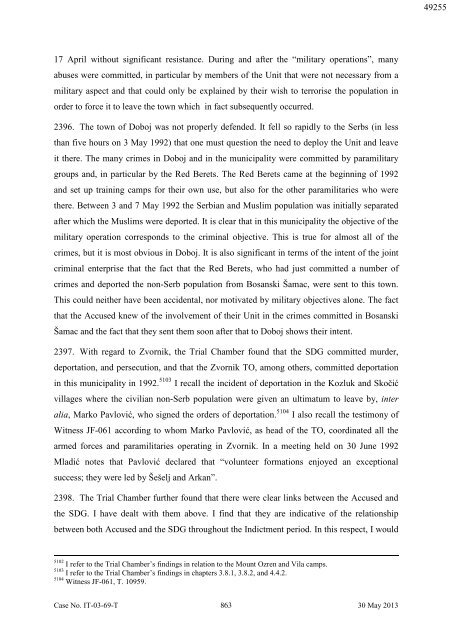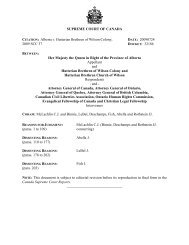- Page 1 and 2:
IT-03-69-T D49681 - D49230 49681 UN
- Page 3 and 4:
49679 3.4.2 Incidents of deportatio
- Page 5 and 6:
49677 Operation Pauk November 1994-
- Page 7 and 8:
49675 5. The law on responsibility
- Page 9 and 10:
49673 According to the Appeals Cham
- Page 11 and 12:
49671 the plan be executed in the a
- Page 13 and 14:
49669 6. The Accused’s responsibi
- Page 15 and 16:
49667 criminal enterprise in Belgra
- Page 17 and 18:
49665 employ assets and methods, an
- Page 19 and 20:
49663 disclosed confidential inform
- Page 21 and 22:
49661 1281. In relation to the inve
- Page 23 and 24:
49659 1286. Based on the foregoing,
- Page 25 and 26:
49657 members of the unit did not i
- Page 27 and 28:
49655 Serb from Knin municipality,
- Page 29 and 30:
49653 1302. The Trial Chamber now t
- Page 31 and 32:
49651 further engagement. Simatovi
- Page 33 and 34:
49649 the media portrayed the train
- Page 35 and 36:
49647 Captain Dragan provided train
- Page 37 and 38:
49645 Crnogorac), Dragan Pupovac, a
- Page 39 and 40:
49643 witness, the MUP in Knin and
- Page 41 and 42:
49641 Knin, though he knew he had s
- Page 43 and 44:
49639 back to their original police
- Page 45 and 46:
49637 but then returned to the Kraj
- Page 47 and 48:
49635 1360. Contrary to the Defence
- Page 49 and 50:
49633 commander Živojin Ivanović
- Page 51 and 52:
49631 Knin Fortress and Korenica ca
- Page 53 and 54:
49629 written autobiographies, Mile
- Page 55 and 56:
49627 1390. Witness JF-039 testifie
- Page 57 and 58:
49625 fortress between October and
- Page 59 and 60:
49623 1401. The Trial Chamber now t
- Page 61 and 62:
49621 formed, its core was made up
- Page 63 and 64:
49619 remained under Martić’s co
- Page 65 and 66:
49617 Serbian MUP. 2631 One of thes
- Page 67 and 68:
49615 1991. The Trial Chamber under
- Page 69 and 70:
49613 organized the financing, trai
- Page 71 and 72:
49611 they were candidates for the
- Page 73 and 74:
49609 1438. A few days after their
- Page 75 and 76:
49607 Mijović, Captain Dragiša Gr
- Page 77 and 78:
49605 majority of the lists. 2708 S
- Page 79 and 80:
49603 and bring them the money. 272
- Page 81 and 82:
49601 logically fit into a sequence
- Page 83 and 84:
49599 terrorist platoon who would s
- Page 85 and 86:
49597 the unit that he had met with
- Page 87 and 88:
49595 Western Srem. 2794 In a form
- Page 89 and 90:
49593 and berets as well as other i
- Page 91 and 92:
49591 admitting new volunteers into
- Page 93 and 94:
49589 of the “Special Unit of the
- Page 95 and 96:
49587 1490. The Trial Chamber will
- Page 97 and 98:
49585 1494. The Stanišić Defence
- Page 99 and 100:
49583 minutes of two meetings of th
- Page 101 and 102:
49581 Pajzoš camp at Ilok and Bosa
- Page 103 and 104:
49579 knowledge engage in any comba
- Page 105 and 106:
49577 in Bosanski Šamac the witnes
- Page 107 and 108:
49575 1524. On 21 April 1992, Nikol
- Page 109 and 110:
49573 who remained in Ilok styled t
- Page 111 and 112:
49571 Ležimir camp above, the Tria
- Page 113 and 114:
49569 Interior Pavle Bulatović, Bu
- Page 115 and 116:
49567 called Žika Crnogorac (which
- Page 117 and 118:
49565 1561. On 29 September 1992, C
- Page 119 and 120:
49563 Petar Djukić and a number of
- Page 121 and 122:
49561 Mount Ozren camp several time
- Page 123 and 124:
49559 listed amounts very high. 307
- Page 125 and 126:
49557 1582. The witness recognized
- Page 127 and 128:
49555 any insignia. 3123 They told
- Page 129 and 130:
49553 1592. At the Kula ceremony in
- Page 131 and 132:
49551 1598. The Trial Chamber now t
- Page 133 and 134:
49549 1606. The Trial Chamber has n
- Page 135 and 136:
49547 his colleague that Simatović
- Page 137 and 138:
49545 1619. Witness JF-048, a forme
- Page 139 and 140:
49543 he saw them salute him in Baj
- Page 141 and 142:
49541 the meeting was how to assist
- Page 143 and 144:
49539 specific portion of his prior
- Page 145 and 146:
49537 Vinko Pandurević were also p
- Page 147 and 148:
49535 joined the unit between May 1
- Page 149 and 150:
49533 subordinate themselves to the
- Page 151 and 152:
49531 Special Units Command and its
- Page 153 and 154:
49529 witness and others were infor
- Page 155 and 156:
49527 1672. The Trial Chamber will
- Page 157 and 158:
49525 Trial Chamber finds that the
- Page 159 and 160:
49523 1680. The Trial Chamber will
- Page 161 and 162:
49521 subordinated to the 1st Bratu
- Page 163 and 164:
49519 1691. In addition to the abov
- Page 165 and 166:
49517 appear on JATD payment lists
- Page 167 and 168:
49515 from May 1993, the Unit in Br
- Page 169 and 170:
49513 had given a speech at the eve
- Page 171 and 172:
49511 member Vasilije Mijović 3418
- Page 173 and 174:
49509 Knin. 3433 The biography of M
- Page 175 and 176:
49507 support, and other substantia
- Page 177 and 178:
49505 or early October 1995, the Re
- Page 179 and 180:
49503 1742. An intelligence report
- Page 181 and 182:
49501 on the frontline, regardless
- Page 183 and 184:
49499 6.4 The Serbian Volunteer Gua
- Page 185 and 186:
49497 057 is attacked in the Final
- Page 187 and 188:
49495 dark red berets. The SDG oper
- Page 189 and 190:
49493 Pelević, Witness C-015, Witn
- Page 191 and 192:
49491 1781. Two witnesses provided
- Page 193 and 194:
49489 conversation between Arkan an
- Page 195 and 196:
49487 1790. To the extent that TO c
- Page 197 and 198:
49485 1797. The witness testified t
- Page 199 and 200:
49483 September and October 1995, t
- Page 201 and 202:
49481 ordered to go to Mrkonjić Gr
- Page 203 and 204:
49479 1813. Based on the foregoing,
- Page 205 and 206:
49477 who came voluntarily to fight
- Page 207 and 208:
49475 supplies through his relation
- Page 209 and 210:
49473 1834. The Simatović Defence
- Page 211 and 212:
49471 reference to the Serbian MUP
- Page 213 and 214:
49469 Major Gavrilović, a.k.a. Brn
- Page 215 and 216:
49467 1853. The Trial Chamber recal
- Page 217 and 218:
49465 Zvornik. In light of the abov
- Page 219 and 220:
49463 Momčilo Krajišnik, Arkan st
- Page 221 and 222:
49461 could propose to the Serbian
- Page 223 and 224:
49459 money came from the Serbian D
- Page 225 and 226:
49457 authority during their deploy
- Page 227 and 228:
49455 6.4.5 The Accused directed an
- Page 229 and 230:
49453 witness that the money arrive
- Page 231 and 232:
49451 member was wounded, their med
- Page 233 and 234:
49449 Arkan needed DB approval for
- Page 235 and 236:
49447 from late November 1994 onwar
- Page 237 and 238:
49445 Chamber also finds based on t
- Page 239 and 240:
49443 6.5 Skorpions 6.5.1 Introduct
- Page 241 and 242:
49441 of the Krajina oil industry a
- Page 243 and 244:
49439 four Ss on the left shoulder
- Page 245 and 246:
49437 1931. Witness JF-027, a Croat
- Page 247 and 248:
49435 1935. The Trial Chamber will
- Page 249 and 250:
49433 unlimited power given to him
- Page 251 and 252:
49431 Mrgud was to pay Arkan’s me
- Page 253 and 254:
49429 halted in December 1994 and r
- Page 255 and 256:
49427 at the Forward Command Post o
- Page 257 and 258:
49425 Abdić’s forces, the Serbia
- Page 259 and 260:
49423 Ulemek. 4026 Medić. 4027 Acc
- Page 261 and 262:
49421 present in Velika Kladuša. 4
- Page 263 and 264:
49419 Cyrillic Ss, which they used
- Page 265 and 266:
49417 Command: the Tactical Group 1
- Page 267 and 268:
49415 and heard those present there
- Page 269 and 270:
49413 1988. The Trial Chamber will
- Page 271 and 272:
49411 information about the MUP uni
- Page 273 and 274:
49409 Slunj, in the Korenica region
- Page 275 and 276:
49407 that he was exaggerating, and
- Page 277 and 278:
49405 Court. 4189 The Trial Chamber
- Page 279 and 280:
49403 not received sufficient evide
- Page 281 and 282:
49401 headquarters. 4204 In cross-e
- Page 283 and 284:
49399 orders from the Serbian SDB.
- Page 285 and 286:
49397 MUP special unit directly con
- Page 287 and 288:
49395 Marić, had been killed. 4256
- Page 289 and 290:
49393 is unable to conclude that th
- Page 291 and 292:
49391 operation. In the absence of
- Page 293 and 294:
49389 300 men, and was stationed in
- Page 295 and 296:
49387 activities of the unit in Bar
- Page 297 and 298:
49385 finds that between late Augus
- Page 299 and 300:
49383 has received evidence from Wi
- Page 301 and 302:
49381 of Serbia in response to a re
- Page 303 and 304:
49379 October 1995), and that the S
- Page 305 and 306:
49377 2077. Witness JF-035, a Serb
- Page 307 and 308:
49375 with Rajo Božović. 4365 On
- Page 309 and 310:
49373 he only saw four of the per d
- Page 311 and 312:
49371 Vasilije Mijović, Dragan Fil
- Page 313 and 314:
49369 witness testified that the Sk
- Page 315 and 316:
49367 the Tara camp, and the genera
- Page 317 and 318:
49365 well as through documentary m
- Page 319 and 320:
49363 could be brought, although at
- Page 321 and 322:
49361 2118. Mile Bosnić testified
- Page 323 and 324:
49359 figure of a parallel structur
- Page 325 and 326:
49357 which he brought items in a b
- Page 327 and 328:
49355 JNA which had unlimited freed
- Page 329 and 330:
49353 Knin municipality, 4527 and f
- Page 331 and 332:
49351 2144. The Stanišić Defence
- Page 333 and 334:
49349 following the 1990 elections.
- Page 335 and 336:
49347 to assist during Belgrade’s
- Page 337 and 338:
49345 2163. Radoslav Maksić, a Ser
- Page 339 and 340:
49343 DST-043, a Serb from Knin, 45
- Page 341 and 342:
49341 issued in their names. 4604 T
- Page 343 and 344:
49339 Plaški to Bosnia, who had le
- Page 345 and 346:
49337 usually a civilian, designate
- Page 347 and 348:
49335 witness was involved in a tra
- Page 349 and 350:
49333 2193. The Trial Chamber has r
- Page 351 and 352:
49331 formal establishment on 29 Ma
- Page 353 and 354:
49329 Chamber observes that after i
- Page 355 and 356:
49327 6.6.4 The Accused failed to i
- Page 357 and 358:
49325 Ilija Končarević was appoin
- Page 359 and 360:
49323 accordance with these instruc
- Page 361 and 362:
49321 requested Milošević to orde
- Page 363 and 364:
49319 to the Accused. In the view o
- Page 365 and 366:
49317 Administration in Belgrade, a
- Page 367 and 368:
49315 2244. According to Witness JF
- Page 369 and 370:
49313 Selo, as it was the easiest w
- Page 371 and 372:
49311 receiving their salaries from
- Page 373 and 374:
49309 warehouse. Furthermore, in vi
- Page 375 and 376: 49307 command staff of the JNA. 482
- Page 377 and 378: 49305 Luković, “Žuča” and hi
- Page 379 and 380: 49303 Serb MUP would take care of t
- Page 381 and 382: 49301 contributions of state-owned
- Page 383 and 384: 49299 very close. Either way, recal
- Page 385 and 386: 49297 6.8 Channels of communication
- Page 387 and 388: 49295 Milošević around 20 times.
- Page 389 and 390: 49293 Belgrade to take a particular
- Page 391 and 392: 49291 Bosnian-Serb Republic into th
- Page 393 and 394: 49289 left for us to do. […] Or w
- Page 395 and 396: 49287 contributions to the discussi
- Page 397 and 398: 49285 commission of crimes, and tha
- Page 399 and 400: 49283 issued a directive to VRS for
- Page 401 and 402: 49281 2328. In addition to the trai
- Page 403 and 404: 49279 cooperate with Milan Martić
- Page 405 and 406: 49277 conclude that Stanišić dire
- Page 407 and 408: 49275 2341. The Trial Chamber now t
- Page 409 and 410: 49273 2347. According to documentar
- Page 411 and 412: 49271 came under fire from Croatian
- Page 413 and 414: 49269 planning meeting before the a
- Page 415 and 416: 49267 7. Disposition 2362. The Tria
- Page 417 and 418: 49265 paramilitary operations beyon
- Page 419 and 420: 49263 arranging weapons and oversee
- Page 421 and 422: 49261 noted that Milošević was al
- Page 423 and 424: 49259 2386. The most important tool
- Page 425: 49257 members showed MUP ID cards,
- Page 429 and 430: 49253 autumn 1991 or in the beginni
- Page 431 and 432: 49251 Accused knew (majority: must
- Page 433 and 434: 49249 activity of the Serb forces w
- Page 435 and 436: 49247 maintaining Serb military and
- Page 437 and 438: 49245 alone 350 per cent. 5113 In f
- Page 439 and 440: 49243 2422. Arrest, transfer, and i
- Page 441 and 442: 49241 Pre-trial Chamber, the Simato
- Page 443 and 444: 49239 Conference to 2 June 2009. 51
- Page 445 and 446: 49237 a gastroenterologist should e
- Page 447 and 448: 49235 complications surrounding his
- Page 449 and 450: 49233 the Prosecution’s rebuttal
- Page 451 and 452: 49231 Krnojelac Trial Judgement: Pr

















